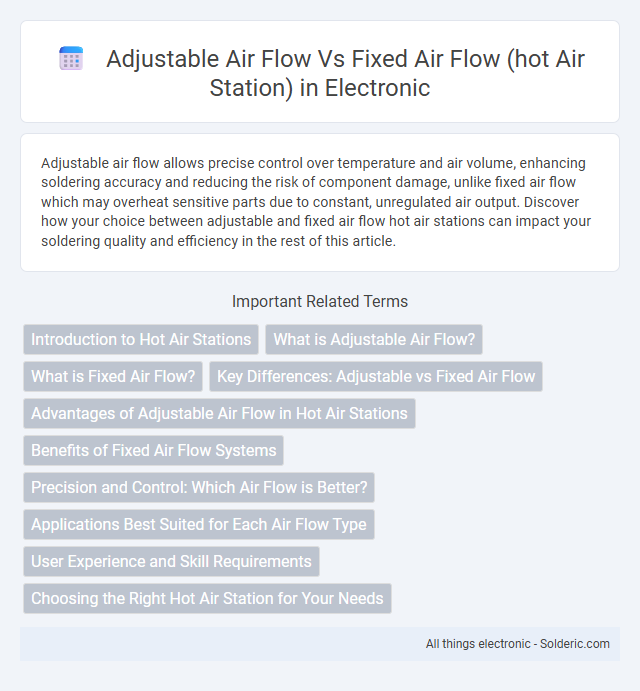Adjustable air flow allows precise control over temperature and air volume, enhancing soldering accuracy and reducing the risk of component damage, unlike fixed air flow which may overheat sensitive parts due to constant, unregulated air output. Discover how your choice between adjustable and fixed air flow hot air stations can impact your soldering quality and efficiency in the rest of this article.
Comparison Table
| Feature | Adjustable Air Flow | Fixed Air Flow |
|---|---|---|
| Air Flow Control | Variable air flow speed settings | Single, constant air flow speed |
| Precision | High precision for delicate tasks | Less precise, suitable for general use |
| Flexibility | Adaptable to various components and applications | Limited to one airflow intensity |
| Temperature Stability | Better temperature control with adjustable air flow | Stable but less optimized for sensitive jobs |
| User Control | Manual adjustment enhances user control | No user adjustment possible |
| Cost | Generally higher due to advanced features | Lower cost, simpler design |
| Applications | Ideal for PCB repair, soldering, and delicate electronics | Suitable for basic heating and general tasks |
Introduction to Hot Air Stations
Hot air stations with adjustable airflow offer precise temperature and air volume control, essential for delicate soldering and desoldering tasks. Fixed airflow models provide consistent and stable air output, suitable for repetitive and simpler applications. Your choice depends on the complexity of the components and the level of accuracy required for reliable results.
What is Adjustable Air Flow?
Adjustable air flow in a hot air station allows precise control over the volume and speed of heated air released, enabling tailored heat application for different soldering tasks. Unlike fixed air flow systems that deliver a constant air output, adjustable air flow enhances accuracy, reduces the risk of component damage, and improves efficiency when working on delicate electronics or varied materials. Your soldering process benefits from this flexibility by adapting heat intensity to specific components, ensuring optimal results and minimizing rework.
What is Fixed Air Flow?
Fixed air flow in a hot air station refers to a preset, unchangeable output of hot air volume and speed during operation. This configuration provides consistent heat delivery, ideal for repetitive tasks requiring uniform temperature control, but lacks the flexibility to adjust airflow intensity based on varying soldering needs. Users prioritizing precision adjustments often opt for adjustable air flow models, which allow tailoring the hot air output to specific components and projects.
Key Differences: Adjustable vs Fixed Air Flow
Adjustable air flow in hot air stations allows precise control over the temperature and speed of the airflow, enhancing soldering accuracy and preventing component damage. Fixed air flow models provide a constant air volume, which may simplify usage but limit versatility for delicate or varied tasks. Your choice impacts the efficiency and safety of rework operations, especially when handling sensitive electronic components.
Advantages of Adjustable Air Flow in Hot Air Stations
Adjustable air flow in hot air stations allows precise control over the temperature and airflow intensity, enhancing the versatility for delicate components and complex soldering tasks. It reduces the risk of overheating sensitive parts and improves energy efficiency by delivering the exact amount of hot air needed. This flexibility results in higher-quality repairs and extends the lifespan of both the tools and electronic components.
Benefits of Fixed Air Flow Systems
Fixed air flow systems in hot air stations provide consistent temperature and airflow, ensuring precise and reliable soldering results ideal for sensitive electronic components. Their stable output reduces the risk of thermal shock and damage, enhancing overall process repeatability and product quality. You benefit from simplified operation and lower maintenance due to fewer mechanical adjustments and parts involved.
Precision and Control: Which Air Flow is Better?
Adjustable air flow in a hot air station offers superior precision and control, allowing users to tailor the airflow to specific soldering tasks and component sensitivities. Fixed air flow settings can limit versatility, often leading to inconsistent heat application and potential damage to delicate electronics. Optimal soldering outcomes rely on the ability to fine-tune airflow, making adjustable air flow the preferred choice for precise temperature management and effective component protection.
Applications Best Suited for Each Air Flow Type
Adjustable air flow in hot air stations offers precise control for delicate electronics, soldering, and rework tasks, making it ideal for complex components and sensitive circuit boards. Fixed air flow models provide consistent heat output suited for repetitive, high-volume soldering or desoldering where uniform airflow ensures reliability without constant adjustments. Your choice depends on whether precision or steady performance best matches your specific application needs.
User Experience and Skill Requirements
Adjustable air flow in hot air stations allows users to customize temperature and airflow settings, providing greater control for delicate soldering tasks and improving user experience by accommodating various skill levels. Fixed air flow models offer simplicity, making them ideal for beginners but limiting precision in complex or sensitive applications. Your choice between these options impacts efficiency and the quality of your soldering work depending on your proficiency and project demands.
Choosing the Right Hot Air Station for Your Needs
Selecting between adjustable air flow and fixed air flow hot air stations depends on your specific soldering tasks and precision requirements. Adjustable air flow models offer greater control over temperature and airflow, enabling you to handle delicate components and varied materials with accuracy, while fixed air flow stations provide consistent output suitable for repetitive, less detailed work. Your decision should consider the complexity of projects and the need for customization to optimize soldering performance effectively.
adjustable air flow vs fixed air flow (hot air station) Infographic

 solderic.com
solderic.com